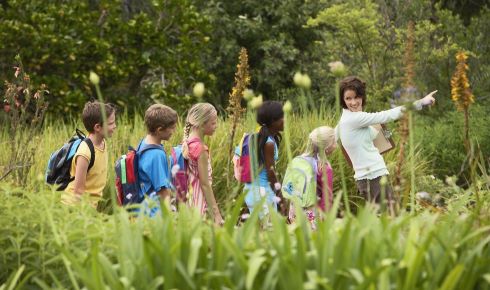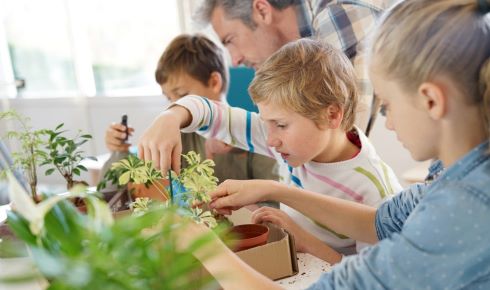It's time to teach the power of plants properly

There are even greater knowledge gaps affecting fungi, with just 0.4% of described fungal species having had their conservation status assessed and potentially millions of fungal species yet to be described.
23rd February 2024
Education experts Bethan Stagg and Justin Dillon explore how to make plants central to future generations’ understanding of the world and the sustainability of the planet
Plants and plant diversity drive the ecosystems on which all other life forms depend. What’s more, they are crucial for stabilising ecosystems experiencing rapid environmental change¹ and for mitigating the adverse effects of climate change².
However, as The Biologist's special report shows, up to 45% of flowering plant species are now at risk of extinction and plant biodiversity is in decline across the world. These are just the plants we know about: the report finds huge gaps in our understanding of the world’s plants and their distribution, with up to three-quarters of undescribed plant species predicted to be at risk of extinction too.
There are even greater knowledge gaps affecting fungi, with just 0.4% of described fungal species having had their conservation status assessed and potentially millions of fungal species yet to be described.
Biology educators have long bemoaned the lack of reference to plants in the curricula of both schools and universities. Neither the importance of plants for sustainability, nor the threats facing many of them, are adequately represented in science education. Hershey³ considered the demise in botany to be due mainly to a failure to communicate the relevance of plants to our lives, a point that has been echoed by other authors since – or, as Kletečki et al put it, “plants are not boring, school botany is”4.
Interactions with plants
The key finding of our recent literature review5 on this topic was that plant awareness develops where people have frequent interactions with plants that have direct relevance to their lives. However, understanding plants’ role in sustainability requires more than just an awareness of certain species and their importance. It requires practical skills, ranging from identification to habitat management and horticultural production, as well as a personal motivation to take action and a social commitment to support others in wider-ranging activities, whether that be citizen science, growing food or protecting pollinators.
We believe that it is important to include plant topics in sustainability education at the school curriculum and educational policy levels. The RSB’s Curriculum Framework6, Evolving 5-19 Biology, for example, recommended “inclusion of plant-related learning opportunities in all levels of the biology curriculum, to help overcome ‘plant blindness’ by fostering increased engagement with and knowledge of plants and other organisms”.
Fiel’ardh et al have proposed aligning the concept of ‘plants, people, planet’ in education to highlight the interrelationships between human activities, plant diversity and ecosystem health within the pillars of sustainability (economic, social and environmental)7. An alternative approach, suggested by Amprazis and Papadopoulou, is to use the 17 UN Sustainable Development Goals8 as a framework for communicating the multi-faceted importance of plants, explaining how they relate to each goal9.
Embedding plants in sustainability education is no small challenge, since biological diversity and the ecological crisis are already sidelined in many sustainability policies and debates, with biodiversity often treated as a sub-topic to climate change. One literature analysis found that climate change received up to eight times more media coverage than biodiversity10.
Therefore, we need educational approaches that raise awareness about biodiversity more broadly. For example, Professor Miles Richardson’s ‘biodiversity stripes’11, which show the temporal decline of biodiversity using a strip of stripes that change from green to grey, are much like the blue and red ‘climate stripes’ that have become a symbol of the urgency of climate change on social media.
 The RSB's recent Curriculum Framework suggested the inclusion of more plant-focused topics at all ages.
The RSB's recent Curriculum Framework suggested the inclusion of more plant-focused topics at all ages. In terms of promoting personal motivation to improve the environment, it has long been established that knowledge alone does not modify behaviour. There exists a tension between science education’s focus on knowledge and skill acquisition, and environmental education’s aims to raise awareness, influence behaviour and bring about affective change.
Yet many educational interventions continue to focus primarily on improving cognitive learning gains while paying limited attention to impacts on actions. It is the behavioural change we need to develop learners’ ecological literacy and agency.
How, then, do we foster affective change towards plants? Fiel’ardh et al suggested applying Mezirow’s ‘transformative learning theory’ to improve plant awareness. This involves challenging trainee teachers’ existing assumptions about plants and their importance, and facilitating critical reflection on the role of plants in the environment8. The authors also highlighted the importance of narrative-based approaches for stimulating interest and critical reflections, a strategy that we employed in schools, using drama to teach about plant diversity12.
Meaningful experiences
Meanwhile Beasley et al suggest that focusing on learners’ local environments may render their experiences with plants more relevant and meaningful, and allow for a growing appreciation and empathy towards plants, especially as students return to a specific place through the seasons¹³.
These approaches overlap with the idea of ‘nature connectedness’, a contested term that aims to measure an individual’s affinity with nature, arising from regular, high-quality interactions with it, and which ultimately leads to the development of pro-environmental beliefs and behavioural change. Plants of course provide an excellent opportunity for developing nature connections, since wild plants are ubiquitous in even the most built-up environment – as our video on ‘pavement plants’ explains14.
Connecting with plants does not just have to be part of outdoor learning. Plants in the classroom (or seminar room) are a valuable resource, and can include local wild plants, to again foster connections with the biodiversity that children encounter (albeit passively) every day, an approach we have been exploring in a series of webinars and a forthcoming open access course for educators.
We look forward to a time when plants feature more prominently in climate change and sustainability education, and hope these ideas contribute to that aim.
This article was adapted from a longer editorial in the latest issue of The Journal of Biological Education. Bethan Stagg has created webinars on fostering plant awareness for biology teachers and environmental education practitioners.
1) MacDougall, A. S. et al. Diversity loss with persistent human disturbance increases vulnerability to ecosystem collapse. Nature 494(7435), 86–89 (2013).
2) Ferrini, F. et al. Role of vegetation as a mitigating factor in the urban context. Sustainability 12(10), 4247 (2020).
3) Hershey, D. R. A historical perspective on problems in botany teaching. The American Biology Teacher 58(6), 340–347 (1996).
4) Kletečki, N. et al. Plants are not boring, school botany is. Educ. Sci. 13(5), 489 (2023).
5) Stagg, B. C. & Dillon, J. Plant awareness is linked to plant relevance: a review of educational and ethnobiological literature (1998–2020). Plants People Planet 4(6), 579–592 (2022).
6) Evolving 5–19 Biology: recommendations and framework for 5–19 biology curricula. RSB, 2021. Curriculum framework development (rsb.org.uk)
7) Fiel’ardh, K. et al. Integrating perspectives from education for sustainable development to foster plant awareness among trainee science teachers: a mixed methods study. Sustainability 15(9), 7395 (2023).
9) Amprazis, A. & Papadopoulou, P. Primary school curriculum contributing to plant blindness: assessment through the biodiversity perspective. Advances in Ecological and Environmental Research 3(11), 238–256 (2018).
10) Legagneux, P. et al. Our house is burning: discrepancy in climate change vs biodiversity coverage in the media as compared to scientific literature. Front. Ecol. Evol. 5(175) (2018).
11) biodiversitystripes.info/natureusage
12) Stagg, B. C. Meeting Linnaeus: improving comprehension of biological classification and attitudes to plants using drama in primary science education. Research in Sci, Tech. Educ. 38(3), 253–271 (2020).
13) Beasley, K. et al. A framework for supporting the development of botanical literacies in early childhood education. Int. J. Early Child. 53(2), 119–137 (2021).
14) In between the cracks: getting to know our wild urban plants. FSC Biodiversity on YouTube. youtube.com/watch?v=m9u7DwnPMYs
Dr Bethan Stagg MRSB is a research Fellow at the University of Exeter’s School of Education.
Justin Dillon FRSB is professor of science and environmental education at University College London and guest professor at Zhejiang University, China.


